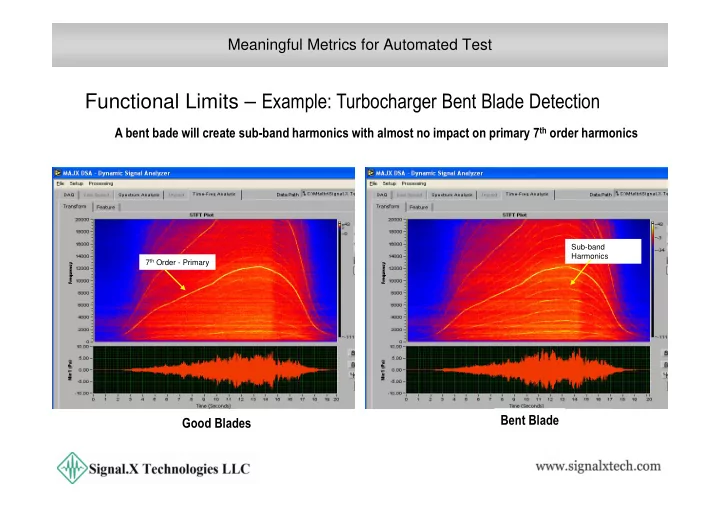

Meaningful Metrics for Automated Test Functional Limits – Example: Turbocharger Bent Blade Detection A bent bade will create sub-band harmonics with almost no impact on primary 7 th order harmonics Sub-band Harmonics 7 th Order - Primary Bent Blade Good Blades
Meaningful Metrics for Automated Test Functional Limits – Example: Turbocharger Bent Blade Detection Demonstration: • First convert to Rev domain for order analysis
Meaningful Metrics for Automated Test Functional Limits – Example: Turbocharger Bent Blade Detection Demonstration: • Compute the Power Spectrum, • Restrict computation to a fixed speed range using triggers for repeatability Triggers locate rev position where speed criteria is met
Meaningful Metrics for Automated Test Functional Limits – Example: Turbocharger Bent Blade Detection Demonstration: • Compute the Liftered Spectrum • Used later to ‘flatten’ the Power spectrum
Meaningful Metrics for Automated Test Functional Limits – Example: Turbocharger Bent Blade Detection Demonstration: • Use Feature Math operations to divide by Liftered spectrum • ‘flatten’ the Power spectrum
Meaningful Metrics for Automated Test Functional Limits – Example: Turbocharger Bent Blade Detection Demonstration: • Use the Functional limits Editor to Create an Upper Limit function to use in exceedance computations
Meaningful Metrics for Automated Test Functional Limits – Example: Turbocharger Bent Blade Detection Demonstration: • Apply the functional limit and produce an Out of Limit List of points exceeding the limit • Use % of limit as the unit of exceedance and sum the Ool List to form a metric
Meaningful Metrics for Automated Test Functional Limits – Example: Turbocharger Bent Blade Detection Demonstration: • Form a decision for Pass/Fail • Include other metrics that look for extreme exceedance by any one peak
Recommend
More recommend